Posted by · 1 Comment
Tracy chats with Kevin Guldin, owner of Oley Valley Feed, who shares several important tips on proper feeding of animals in winter.
Posted by · 1 Comment
Tracy chats with Kevin Guldin, owner of Oley Valley Feed, who shares several important tips on proper feeding of animals in winter.
Posted by · 1 Comment
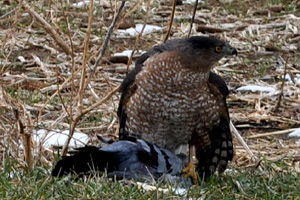 Hawks are routine aerial visitors to our place.
Hawks are routine aerial visitors to our place.
We have many chickens in the barnyard and about a third of the group tends to free-range, flying out of the enclosure in the morning and back in the evening.
You can imagine the “alarm system” that goes off when a hen or rooster spots a circling hawk. It really is quite amazing. The immediate group will stand perfectly still while their heads are cocked toward the sky to spot the predator. The “cry” is unlike any other sound a chicken will make. In the warmer months, I’ll even stop what I’m doing in the yard to see if I can spot the hawk!
Hawks are so brazen, they’ll fly into the barn through an open window (I say this because the entryway doesn’t have to be big; if they want in, they’ll get in) and seek out a meal.
The other day, it was a pigeon.
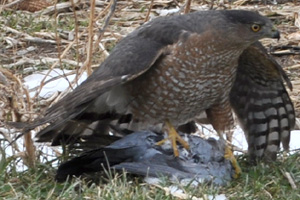
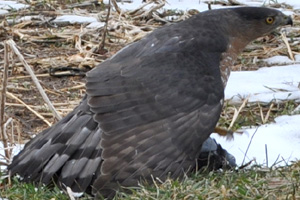 This particular Sharpshin managed to get a pigeon and heave it to the outskirts of the vegetable garden. He sat there for a couple of hours, feasting, and when I slowly made my way to take pictures of this stately bird, he flew off—clutching the pigeon—and alighted atop a tree hundreds of yards away.
This particular Sharpshin managed to get a pigeon and heave it to the outskirts of the vegetable garden. He sat there for a couple of hours, feasting, and when I slowly made my way to take pictures of this stately bird, he flew off—clutching the pigeon—and alighted atop a tree hundreds of yards away.
Since I used to pilot aircraft, I have a professional appreciation for what I had witnessed. Although the hawk had wingspan and girth on the pigeon, to take flight immediately from a “still” position, carrying cargo? Jaw-dropping. Which is exactly why I couldn’t get the camera up in time to snap a picture—I was too busy processing what I had just seen.
Posted by · 3 Comments
Tracy visits Oley Valley Feed, a local feed store, and picks up several important tips on proper watering of livestock in winter.
Posted by · Leave a Comment
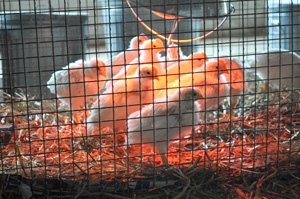
Chicks at 4 weeks old
Unbeknownst to us, a few nights ago (on the coldest, windiest night of the year thus far), we lost the heat lamp on the chicks. It happened in the middle of the night.
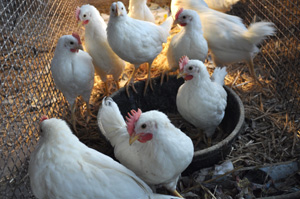
Chicks at 6 weeks old
Fortunately, the “chicks” are about 6 weeks old right now and have full sets of feathers. Typically, if you have chicks in the Spring the heat lamp is kept on them until they develop feathers and/or the weather is warm enough to sustain them, whichever occurs last.
Raising chicks in the winter is a different story. You might need two heat lamps to provide the necessary heat in a situation that would normally require just one in warmer months and you’ve got to be wary of drafts.
It’s also a good idea to have an extra bulb on hand at all times. The heat must be provided around the clock; even newborns, kept in the house, might not have enough heat to sustain themselves without the use of an infrared bulb.
These were the babies that came home with my daughter from school (fourth-graders hatched the chicks using incubators) at the tail-end of Fall—not exactly the ideal climate for raising chicks!
Thankfully, the “babies” had their feathers and everyone made it. We’ll keep them in their pen inside the coop until they grow a little larger. This serves two purposes: their size will mirror the size of the adult birds and will hopefully preclude the “oldies” from picking on the “newbies” and they’ll come to understand the coop as “home.”
Posted by · Leave a Comment
We went to my parents’ in Virginia for Thanksgiving this year.
On Black Friday (I don’t do the “shopping thing” anyway), the family decided to go to the local SPCA.
We’d been seriously considering a dog for the family–most likely a beagle–for over a year (I had been raised with a variety of gun dogs but was on the fence as to the “perfect match” for our family).
Living on a farm, you can imagine the odors that come in with you from the barn on any given day. Not to mention the fact that when you have free-ranging poultry, a bird dog might be taking the kids for a walk instead of the other way around.
Enter “Clark.”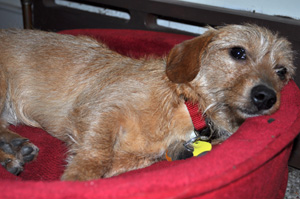
His pen at the SPCA (does anyone say “pound” anymore?) appeared empty when we first passed by (we discovered later he’d been hiding beneath his bed). Literally, as I bent down (waaaay down) to greet him at his gate, an adoption counselor suggested the family and Clark go to a private room together… and that, as they say, was that.
We traveled home to Pennsylvania that following Monday after his neuter. The Fauquier County SPCA brought him up to date on his shots, neutered, and micro-chipped him.
He’s a wire-haired dachshund—I’ll bet very close to full-bred, too. My daughter’s dog breed book says the wire-hair (terrier) was bred into the dachshund so that the coat would add a protective layer when the dogs were hunting in briars and brush. What would they hunt? Badgers, and sometime, foxes; amazing!
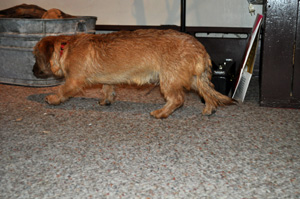
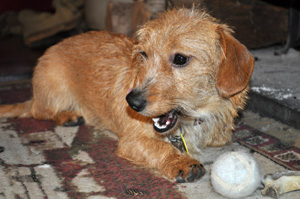
Clark turned one year old the day after Christmas and has settled in nicely here with us. Oh, let’s face it: WE LOVE HIM!! He’s cuddly, smart, obedient, fun, and all-around adorable. You know that old animal adoption adage: who rescued whom? Exactly.
Posted by · Leave a Comment
What’s the connection between an old pair of farm coveralls and French perfume?
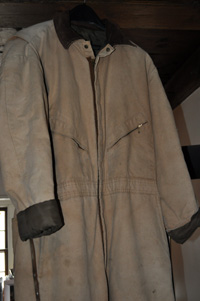

Well, there wasn’t one….until two days ago.
The perfume was a Christmas gift from Lisa, a dear friend who lives in London. I had admired her perfume for years and she surprised me this year with a bottle of my own! It was a lovely gift and I just couldn’t wait to give it a spray…but when?
I think I stayed in my PJs until late in the day on Christmas but on the 26th, as I headed out to the barn to do chores, I walked past the bottle, turned around and gave myself a spritz—right there in those coveralls.
I was smiling as I filled water buckets at the spigot; the wind picking up the scent and carrying it.
Those ole coveralls will never be the same (thankfully)!
Posted by · 1 Comment
Back in the kitchen, Tracy prepares horseradish and demonstrates that this is no job for the faint of heart.
Posted by · 1 Comment
Here we come a-wassailing
Among the leaves so green;
Here we come a-wand’ring
So fair to be seen.
Love and joy come to you,
And to you your wassail too;
And God bless you and send you
a happy New Year.
I made my first batch of wassail five years ago after having visited the Daniel Boone homestead, which is about 20 minutes from here.

 At Christmastime, the homestead was decorated in a colonial manner, of course, and before your tour began, you were offered a cup of hot wassail. That cup, although delicious, varied dramatically from the wassail one enjoyed centuries ago. Today’s version is more like a mulled cider—yesteryear’s incorporated ale and spices with “sops” or toast placed on top to “sop” the liquid.
At Christmastime, the homestead was decorated in a colonial manner, of course, and before your tour began, you were offered a cup of hot wassail. That cup, although delicious, varied dramatically from the wassail one enjoyed centuries ago. Today’s version is more like a mulled cider—yesteryear’s incorporated ale and spices with “sops” or toast placed on top to “sop” the liquid.
Wassail was also part of a ritual offered to apple trees to showcase the current year’s harvest and ensure a healthy harvest the following year. One such ceremony included the election of a village king and queen. The Wassail Queen would be lifted into the boughs of the apple tree to place sops, an offering, so to speak, to the “tree spirits.”
The term “wassail” refers to the salute “Waes Hail” — an Old Norse and Old English phrase meaning “Be in good health.” The consumption of wassail dates as early as the 11th century but, I think, we tend equate it with a later use. Apparently, in the 17th century, it was common to take your bowl of wassail from door to door offering cups to friends and neighbors — thus, “here we come a-wassailing.”
Below is a basic recipe for wassail, compliments of www.about.com
2 tsp whole cloves
3 short cinnamon sticks
1 1/2 tbs crystalized ginger, chopped
1 3/4 cups sugar
4 cups water
4 cups orange juice
1/2 cup lemon juice
8 cups apple juice
Preparation:
In a small piece of cheesecloth, tie a bag with the cloves, cinnamon sticks and ginger pieces. In a saucepan, heat the water, sugar and spice bag until sugar is thoroughly dissolved. Heat on a low simmer for another 15 to 20 minutes. Remove spice bag.In a large punch or serving bowl, stir together the juices and add the spiced sugar water. Stir through and serve while still warm. Serves about 24 people.
So, if you’ve grown tired of taking the holiday platter of cookies to neighbors, why not offer a bowl of wassail and toast to “good health”. Hey, wait a minute: I wonder if that’s where “toast” came from? The sops?? Hmmmm. Time to do a little more research.
Here’s to your health!
Posted by · Leave a Comment
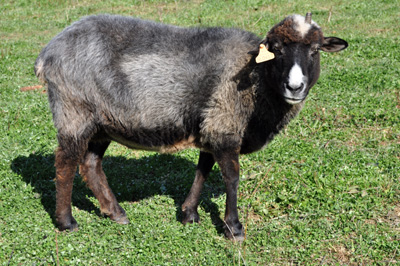 This is Reese, the matriarch of our flock. I took this picture because she was looking “fluffy.” Mind you, it’s not a word I use often when describing my sheep, but it seemed as though her coat had changed, almost overnight. She was sheared six weeks before so she already has over an inch of coat growth.
This is Reese, the matriarch of our flock. I took this picture because she was looking “fluffy.” Mind you, it’s not a word I use often when describing my sheep, but it seemed as though her coat had changed, almost overnight. She was sheared six weeks before so she already has over an inch of coat growth.
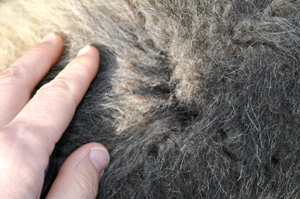
Inner Coat - Wool
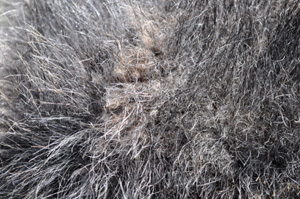
Outer Coat - Hair
The Navajo-Churro fleece consists of both wool and hair. The inner coat of wool is the closest growth to the skin and is a separate layer from the “hair”, which are the longer locks you see draping the sheep later in the season. The inner coat can grow to three to six inches and represents roughly 80 percent of the fleece. The hair, or outer coat, comprises 10 to 20 percent of the fleece and can have a staple length of six to 12 inches.
Reese is my girl (remember in the blog post about the pasture gate—she “called out” that it was open)!! She’ll always walk to me to get a back scratch or shoulder rub but doesn’t like the camera. So for me to be able to snap a quick photo of her fleece was a pretty special occurrence. It’s easiest to see the wool-hair variation on her because of her coloring and markings.
She’s definitely pregnant, too—I can tell—so I’ll make time for lots of back-scratches and shoulder rubs in these coming months.
Posted by · 1 Comment
Chickens are an endless source of entertainment.
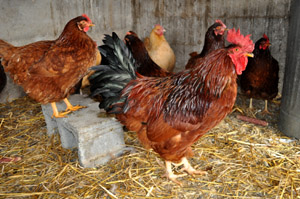 I was late one morning getting to the barn and opening the coop so everyone came charging at me when the doors were finally opened.
I was late one morning getting to the barn and opening the coop so everyone came charging at me when the doors were finally opened.
They know exactly which galvanized can houses the feed corn (a staple which we feed) and which has the chick feed or “crumbles.”
I always feed the chicks first and then move on to the mature birds. When the bag of crumbles rattles, mature hens hop on top of the can and plop themselves into the feed bag as fast as they can.
We have so much hay in the barn. There’s a mound of loose hay David picked up and it rests next to the bales. The chickens LOVE to pick through it! They’ll scratch and hunt all day long in that pile, I’ll sweep it back up at the end of the day, and the next morning it’s scattered.
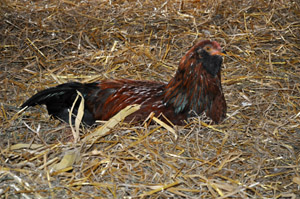
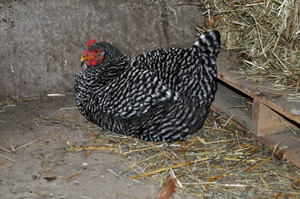
And one of these days I’ll video some of the action that goes on between two hens arguing over the same nesting box (again, we’ve plenty of laying boxes to go around but many choose the same one). Hens can be quite vocal with one another when it comes time to lay.